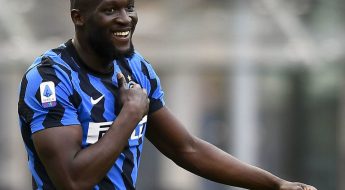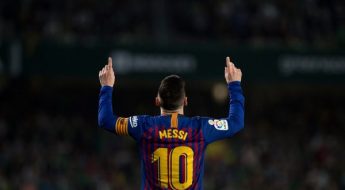Barnwell: Grading the Cam signing, and how the Patriots' offense could thrive
In the end, Cam Newton and the New England Patriots made too much sense for each other. In a league in which every other starting quarterback opportunity was full, the Patriots gave the former NFL MVP his only realistic chance of being a Week 1 starter on a competitive team. And while I don’t doubt that the Patriots still believe Jarrett Stidham is capable of being a starter at the NFL level, the chance to acquire the 2015 MVP when the alternatives were Stidham and Brian Hoyer was always going to interest coach Bill Belichick at the right price.
We might never know whether Belichick delayed the timing of the Newton signing to coincide with the news that the Patriots had lost a third-round pick from the latest in their series of league investigations, but by the time we get to September, it won’t matter. New England might have come away with the bargain of the offseason by agreeing to terms with Newton on a one-year deal, reportedly for the league minimum. Newton also can reportedly make up to $7.5 million in incentives, before he would presumably be able to hit the market again under far better circumstances in 2021.
Jump to the grade for the deal
The facts about Newton’s post-MVP career
To start, there’s very little risk here for the Patriots. They have only about $1.8 million in cap room, so depending on how the incentives are structured, they might need to create additional space to get Newton under contract. They can achieve that by extending guard Joe Thuney or cutting someone such as Rex Burkhead, Deatrich Wise Jr. or Jermaine Eluemunor. If Newton gets hurt or isn’t able to beat out Stidham, New England would presumably be out only about $1 million. When you consider that the organization paid Antonio Brown more than $9 million for one game last season, you can see just how little the Patriots have to lose by adding Newton.
2 Related
Of course, that’s the $7 million question. If we knew that Newton was healthy, there’s little chance he would be available in the market for the league minimum. He hasn’t been healthy for a regular-season snap since the first half of 2018, and with the Newton played excellent football through the first half of 2018. With Carolina sitting pretty at 6-2 in the NFC South, he was 10th in the league in passer rating (100.8) and 12th in QBR (63.1). Often one of the deepest average passers in football, he was given shorter passes to throw and magically improved his completion percentage to 67.3. The former first overall pick was averaging nearly four touchdowns for every interception and producing nearly 280 yards from scrimmage per game. He was fourth on my midseason MVP ballot that year. The Pittsburgh Steelers beat the Panthers 52-21 in Week 10. Pretty quickly, it became clear that Newton’s right shoulder was a problem. He struggled to make throws with zip over the second half of the season, and while he battled through the injury before eventually sitting out in late December, the Panthers collapsed during the second half. He underwent shoulder surgery after the season. It’s important to make this distinction, because if you weren’t paying attention to the Panthers last summer and into the preseason, you might have missed an important piece of information. By all accounts, Newton healed from that shoulder injury. One report from camp lauded the return of his deep ball, which had gone missing as a result of the shoulder injury the prior year. He looked to be back on schedule to return as the Panthers’ primary quarterback, and while I’m sure there would have been some growing pains, there was no suggestion that he was still being bothered by his shoulder when the next injury struck. Newton suffered a Lisfranc injury to his left foot in a preseason loss to Belichick’s Patriots. He sat out the remainder of the preseason before returning for Week 1, but when I watched Newton play against the Los Angeles Rams, I didn’t see a quarterback who was struggling for velocity or arm strength. From how he was moving and how many passes he sailed over his receivers, it was clear he wasn’t comfortable planting his foot. After the issue was even more obvious during a Thursday night loss to the Tampa Bay Buccaneers the following week, the Panthers shut him down. When the injury didn’t heal with rest, the Panthers placed Newton on injured reserve, ending his season. While a Lisfranc injury can be disastrous for receivers, it’s not typically a career-impacting injury for quarterbacks. Matt Schaub hit injured reserve with a Lisfranc injury in 2011 and returned to make the Pro Bowl the following season. Taysom Hill suffered a Lisfranc injury in college, and while it cost the BYU quarterback most of his senior year, he has been able to return and move just fine. Newton should be recovered from both the 2018 shoulder surgery and the 2019 foot surgery. Is it possible Newton has simply taken too many hits and has grown brittle? I suppose, but we have plenty of examples of quarterbacks who suffered multiple serious injuries and were still able to rebuild their career. Tannehill, who is nearly a year older than Newton, comes to mind. Randall Cunningham dealt with an ACL injury in an era in which it was far more career-threatening and came back at 35 to deliver an All-Pro season for the Minnesota Vikings. Steve McNair battled through injury after injury and was a Pro Bowl-caliber passer at age 32 and 33. I don’t know whether Newton will get back to his old self, but it’s premature to write him off. 2:18 Adam Schefter breaks down how the Patriots managed to strike a deal with former MVP quarterback Cam Newton. A healthy Newton has to be considered the favorite to win the starting quarterback job in New England. Stidham was about to become the second player in league history taken after pick No. 100 to start for his team in Week 1 of his second season after not starting as a rookie. While the Patriots were optimistic enough about Stidham’s chances to avoid making a more significant move before now, the most we can say about the 2018 fourth-rounder is that he represented something totally unknown. Before the Newton signing, there was already evidence that the Patriots were going to change their offense. Even the most optimistic Patriots fan couldn’t suggest that Stidham was going to be Tom Brady. He wasn’t going to have Brady’s accuracy, experience reading defenses or ability to avoid turnovers. That was never going to happen. What the Patriots did this offseason, instead, was build around a more run-heavy attack. They put the franchise tag on Thuney, meaning that the Pats are set to spend nearly $28 million on guards this season, $6.5 million more than any other team. They got back David Andrews after their starting center missed the entire season with a pulmonary embolism; signed fullback Danny Vitale to replace the retiring James Develin; and then used a pair of third-round picks on tight ends Dalton Keene and Devin Asiasi, both of whom are regarded as plus blockers. With Stidham, this offense would have likely looked something akin to a modern version of the attack the Patriots ran in 2001, when they had something closer to a 50/50 run/pass split. Brady’s job was to convert friendly third downs and protect the football. It worked: The Patriots were 11th in offensive DVOA and won a Super Bowl with a defense that was only 13th in DVOA. The 2020 Patriots should be much better than that on defense. That formula was going to be competitive with the Buffalo Bills for a division title even before adding Newton. If Newton does win the job, the Patriots probably will build something closer to the offense he was working under during his time with Turner in Carolina. With the Panthers trying to get the ball out of Newton’s hands quicker, the concerns about accuracy and efficiency that might have otherwise made him and the Patriots seem like a bad fit went away. Newton had just four interceptions and four fumbles over the first half of the 2018 campaign. That’s an outlier given the rest of his career, but it’s also the only time Carolina didn’t have a healthy Newton in an offense when the Panthers were expecting him to average 10 air yards per pass attempt. You could also see the Patriots borrow concepts that have worked elsewhere. It wouldn’t be shocking if they were to steal some ideas out of the Greg Roman playbook for Lamar Jackson and use heavy doses of motion to manipulate teams and create opportunities for Newton as a runner. New England has always been aggressive with trying to stay ahead of the offensive curve and attempting to build its offense around what is undervalued. In 2007, the team traded for Randy Moss and Wes Welker and incorporated a spread attack. Three years later, it drafted Rob Gronkowski and Aaron Hernandez, and the offense shifted into becoming 12 personnel. When Chip Kelly took hold with the Philadelphia Eagles, the Patriots were one of the first teams to really emphasize pace and tempo, even before Kelly joined the league. The Baltimore Ravens might have beaten the Patriots to the punch, but Belichick isn’t going to write off the league’s most effective offense as a gimmick. What it all comes back to for me is this: When the Patriots haven’t been able to simply blow past teams with talent like they could in 2007, their core offensive concept has been versatility. Because they’ve had Gronkowski, Develin, Julian Edelman and a variety of versatile running backs, the Patriots have always been able to create a mismatch. They could go three- or four-wide and still have the blocking ability to run the football effectively. When they sent out 22 personnel and made it look like they were going to run the ball, they had the athletes to motion out or work off of play action and beat an opponent’s base defense in the passing game. It’s how the Patriots won their last Super Bowl. Last year, with Gronkowski retired, Develin injured and a replacement-level group of tight ends, the Patriots didn’t have that ability to disguise their intentions with their personnel or the flexibility to shift from one concept to the other. They might have wanted to run the ball more effectively, but when Sony Michel was in the game, they ran it 67% of the time; only two players (who played 300 offensive snaps or more) were better indicators of whether their team was going to run the ball, and one of them was Ravens fullback Patrick Ricard. When James White came in, the Pats threw the ball 81.8% of the time; only three other players were a more obvious tell. New England suffered both running and throwing the football. The Patriots didn’t get Gronkowski back this offseason, but by replenishing at fullback and tight end, they were able to restore some semblance of versatility. By adding Newton to replace Brady, they’ve upgraded that versatility and added uncertainty at the one position where they didn’t have it during the Gronkowski era. They were fine without Brady as a run threat given everything else he could bring to the table; but if Newton is healthy, he can give them a runner who can barrel through undersized boxes out of 10 or 11 personnel or someone who can take advantage as a passer when teams load up the box to stop the run. In that sense, he is less a replacement for Brady and more a replacement for Gronkowski. Having said all that, while the Patriots aren’t incurring much financial risk by signing Newton, there is an opportunity cost that drops this grade ever so slightly. Naturally, there’s a chance he fails his physical, which would render this whole thing a waste of time while simultaneously jabbing at Stidham’s confidence. If Newton stays healthy enough to soak up the majority of the preseason reps with the ones and then suffers a season-ending injury in Week 2, the Patriots will have wasted their time when Stidham could have desperately used those snaps. Even if Newton does stay on the field and plays well enough to start, there’s a chance this doesn’t move the needle for the Patriots. If Newton is the 24th-best quarterback in football, they will probably go 9-7 and not be good enough to beat the
1:53 Dan Orlovsky breaks down how Cam Newton will be utilized with the Patriots, saying Bill Belichick and Josh McDaniels will find new ways to use his skill set.What could the Patriots’ offense look like?
The grade: A-minus
In that dream scenario in which Newton stays healthy and the Patriots compete for a Super Bowl, there’s still some modest downside for the team. They were unable to convince Newton to sign a multiyear deal or get any sort of option on him for 2021 if he excels as the starter. It’s unclear whether the Pats will have the right to franchise him after the season if he does return to form. They’ll be able to afford a tag for him, given that the Pats are projected with more than $86 million in cap space, but if his camp negotiated a tag refusal as part of this deal, the Patriots won’t have a lot of leverage in re-signing him.
This is an obviously smart move for the Patriots, even if it doesn’t work out. Merely having Newton on their roster when he could have served as a high-upside backup for such rivals as the Bills, Ravens, Steelers, Chiefs and Tennessee Titans would have been worth what the Patriots are paying him. For the Patriots to add a starter with Newton’s upside this late in the process is almost a cliché. This has a strong case to become the best free-agent signing of the offseason.





